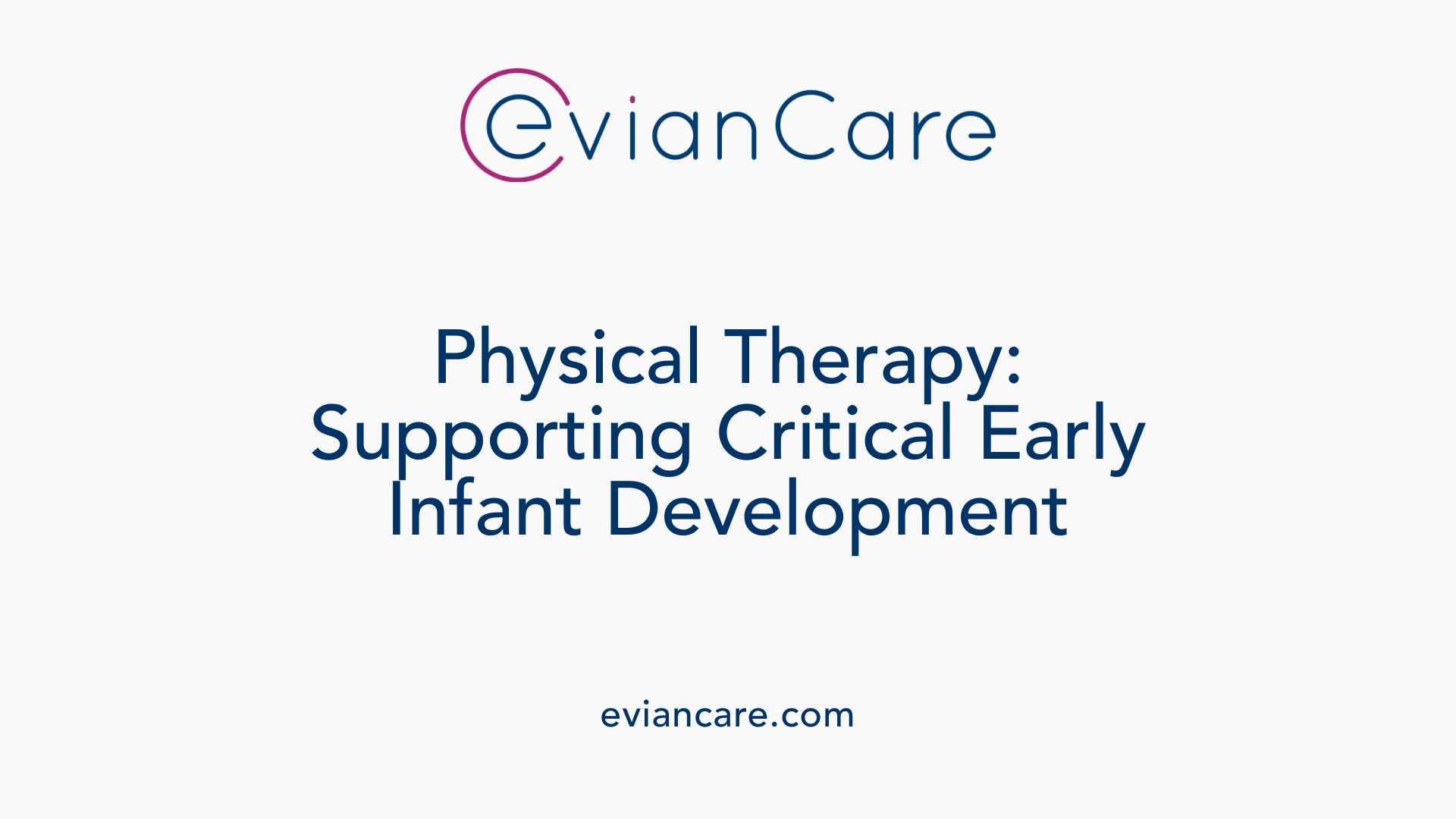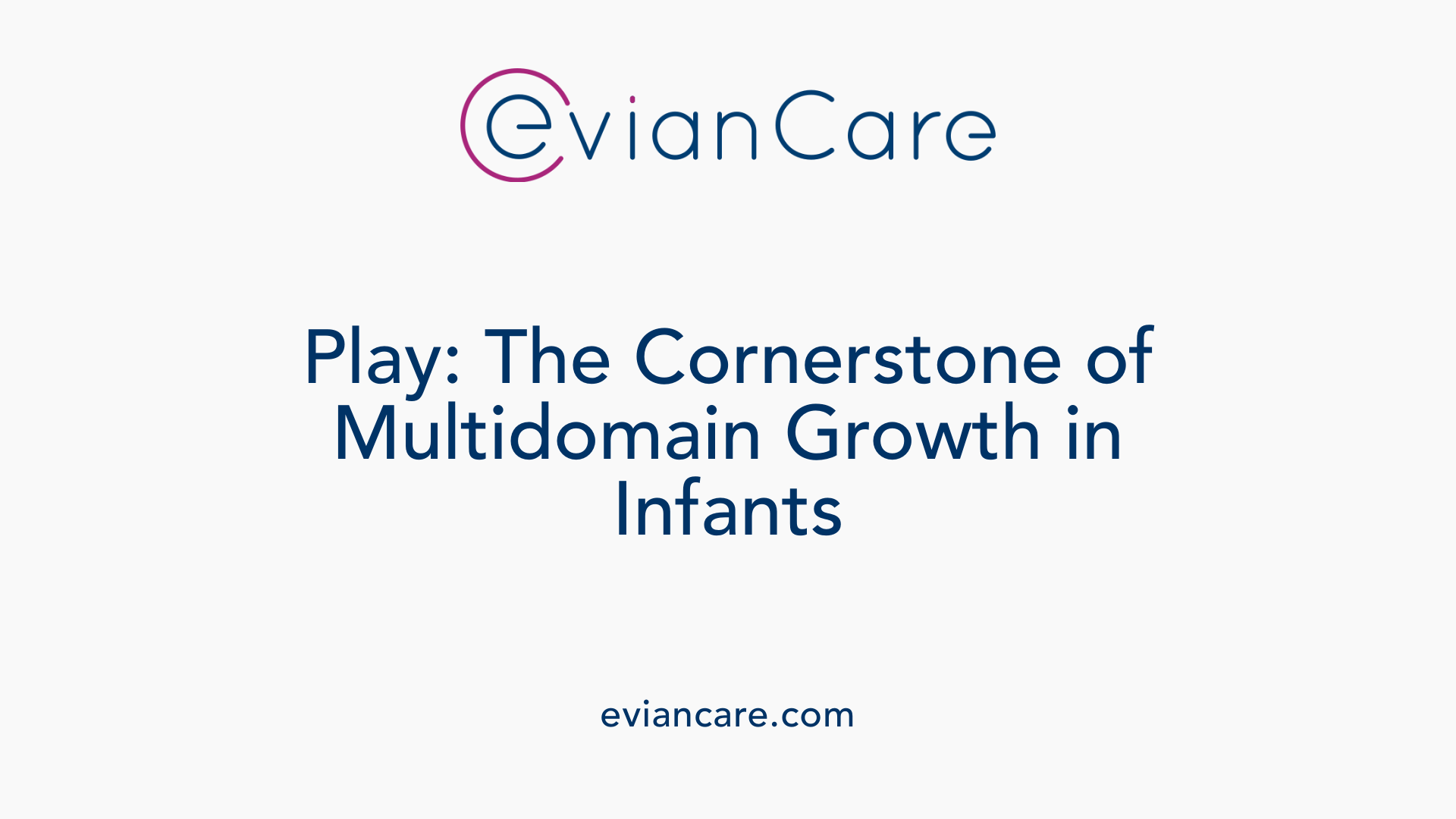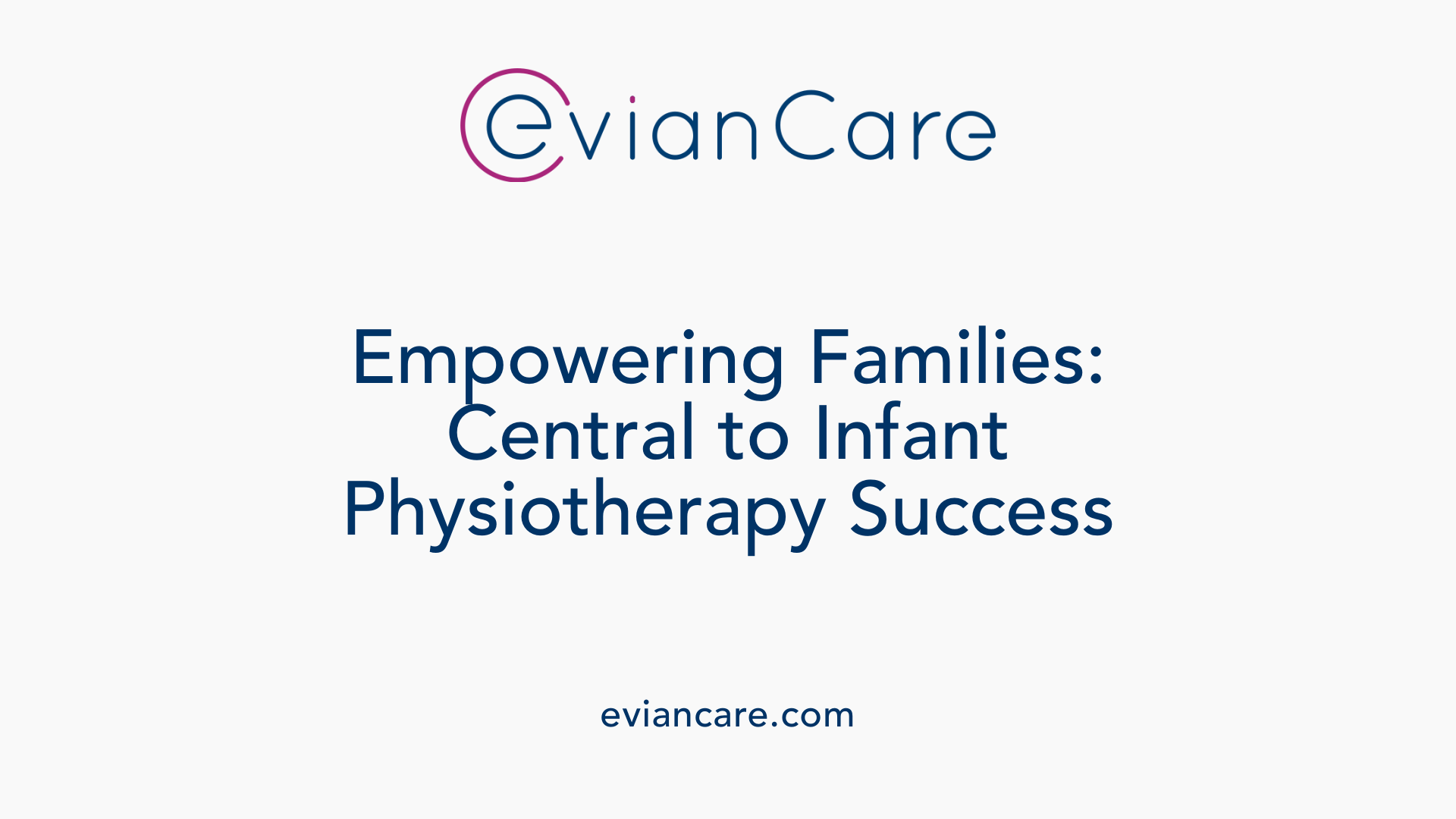
Understanding the Importance of Early Physical Assistance for At-Risk Infants
Supporting developmental progress in infants at risk is a vital aspect of pediatric healthcare. Early physical therapy interventions focus on fostering motor, cognitive, and social-emotional growth, leveraging play-based strategies and individualized plans. This article explores how physical therapy can make a significant difference in the lives of vulnerable infants, emphasizing the role of early detection, family involvement, and evidence-based practices.
The Critical Role of Physical Therapy in Early Infant Development

What is the role and benefit of physical therapy in supporting developmental progress in infants at risk?
Physical therapy is essential for infants at risk of developmental delays, offering targeted interventions that promote motor, cognitive, and sensory growth. Pediatric physical therapists conduct thorough evaluations to understand each child's unique needs and craft personalized treatment plans.
These plans often incorporate specialized techniques such as the Bobath approach, neurodevelopmental treatment (NDT), motor learning principles, and multimodal sensory stimulation. This combination helps infants develop critical skills like rolling, crawling, and walking sooner, while also enhancing balance, posture, and overall movement quality.
By focusing on active, engagement-based activities, therapists help strengthen muscles, improve coordination, and support sensory integration. This early intervention is crucial during the brain's sensitive early years, significantly boosting the child's long-term development.
Collaboration with families is a cornerstone of success. Therapists work closely with caregivers to educate and guide them on supporting their child's progress through home exercises and creating supportive environments.
Research indicates that early, play-centered therapy can positively influence cognitive and motor development, encouraging greater independence and participation in daily activities. This proactive approach not only addresses current issues but also helps prevent secondary problems like poor posture or reduced mobility.
Ultimately, physical therapy tailored to an infant's specific risk factors can dramatically improve developmental outcomes, fostering healthier, more adaptable children.
Play as a Foundation for Multidomain Development in Infants

What is the role of play in early childhood development?
Play is an active process that serves as a natural and enjoyable way for infants and toddlers to explore themselves, their environment, and their interactions with others. Intrinsically motivated, play involves a seamless flow of activities that are pursued for their own sake, making it a vital component for healthy growth.
Engaging in play not only provides entertainment but also lays the groundwork for development across various domains. It promotes motor skills by encouraging movement and coordination, supports language acquisition through interactive communication, enhances cognitive abilities like problem-solving and exploration, and fosters social-emotional growth by promoting interactions, empathy, and self-regulation. Play also nurtures adaptive behaviors, helping infants learn to navigate their surroundings.
How does play support different areas of development?
Research highlights that active play is essential for balancing motor, language, cognitive, social-emotional, and adaptive growth. For instance, playful exploration helps children test their physical limits, which refines their motor control and strength.
In language development, engaging play activities involving pretend scenarios or interactive reading introduce new vocabulary and communication skills. Cognitive development advances through problem-solving during puzzles or spatial explorations within play environments.
On the social-emotional front, shared play promotes bonding and emotional regulation, while fostering independence. Adaptive behaviors such as problem-solving, coping, and self-help skills are also reinforced through playful routines that mimic daily life.
Do children with or at risk of delays demonstrate differences in play?
Children facing developmental challenges, such as those with autism spectrum disorder (ASD), often show notable differences in play behaviors. These children may exhibit atypical exploratory behaviors, engage in repetitive interactions, or show limited symbolic or imaginative play. Recognizing these variations helps professionals tailor interventions to support more typical development and encourage varied play experiences.
Strategies used in pediatric physical therapy to support early development, including play-based approaches
In pediatric physical therapy, therapists leverage the innate appeal of play to facilitate development. They create engaging, motivating environments that respect the child's behavioral cues and follow their lead. This child-centered approach ensures that play remains enjoyable and meaningful.
Therapists structure the environment thoughtfully—choosing appropriate toys, modifying positioning, and integrating activities that promote autonomous movement. Environmental modifications support exploration, independence, and skill development.
Family involvement is integral. Therapists work collaboratively with parents and caregivers, respecting cultural play preferences and routines. Through coaching and support, families learn how to embed therapeutic activities into everyday interactions and play, which maximizes progress.
These combined strategies foster motivation, support neuroplasticity, and encourage developmental milestones, making therapy a more engaging and effective experience for infants at risk of delays.
Identifying the Need for Early Physical Therapy in Infants

What signs indicate that an infant may need early physical therapy intervention?
Recognizing early signs of developmental delays is crucial for timely intervention. Infants who show delays in reaching key milestones—such as rolling over, sitting unsupported, crawling, standing, or walking—may need to be evaluated by a pediatric physical therapist.
Other indicators include persistent limb stiffness or limpness, which can signal abnormal muscle tone. Difficulty with head control or asymmetry—like favoring one side, or developing flat spots on the skull—are also common red flags.
Limited or abnormal movements, poor balance, or struggles during tummy time are signs that an infant may have underlying motor concerns. Signs of stiffness or weakness, difficulty engaging in typical activities, or avoiding weight-bearing movements can also point to the need for assessment.
In addition, limited grasping ability, dragging limbs, or reluctance to participate in age-appropriate activities are important cues. These signs not only hinder development but may also lead to secondary issues if unaddressed.
Early detection of these signs is essential because it allows health professionals to implement support strategies that foster normal growth. Addressing concerns early can improve motor skills, reduce future complications, and support overall development.
Timely intervention through physiotherapy often involves tailored exercises, environmental modifications, and family education. These proactive steps can help prevent secondary problems such as poor posture or mobility issues.
Why is early detection of developmental delays in infants so important?
Detecting delays early ensures that children receive the support they need during a critical window of brain and motor development. Early intervention not only accelerates motor skill acquisition but also contributes positively to cognitive, social, and emotional growth.
Physiotherapists use comprehensive assessments, including observation, standardized tests, and parent interviews, to identify delays. This process helps in developing individualized treatment plans aimed at promoting maximum developmental progress.
Research shows that early physical therapy can lead to significant improvements in motor control, balance, sensory processing, and overall participation in daily activities. It also reduces the need for expensive educational services later in life.
In sum, recognizing the early signs of developmental delays and seeking timely physiotherapy intervention benefits children by supporting their physical capabilities and overall well-being.
Effective Methods to Address Developmental Delays
What methods are used in physical therapy to address developmental delays in infants at risk?
Physiotherapy plays a crucial role in supporting infants who experience developmental delays, utilizing a variety of proven, active approaches. Physical therapists focus on exercises that enhance strength, coordination, and motor control through guided movement activities. These include encouraging head control, reaching, grasping, and other functional movements that promote muscle development and stability.
Positioning strategies are also fundamental. Therapists help optimize an infant’s posture and support to facilitate natural movement patterns and milestones. Manual assistance and adaptive equipment are often employed to support spontaneous exploration and movement.
Many interventions adopt a goal-oriented approach, especially programs like the GAME (Goals–Activities–Motor Enrichment) approach. This involves structured, intensive motor training customized to each child’s needs, coupled with parental education and engaging environmental modifications. Such methods aim to stimulate neuroplasticity and accelerate developmental progress.
Assessment is a vital component. Therapists conduct comprehensive evaluations to identify specific motor delays and craft personalized treatment plans. These plans set measurable objectives and specify intervention intensity and duration.
Implementing these varied strategies early in life ensures that infants receive targeted support, which can significantly improve their motor skills, support exploration, and foster overall development in a timely manner.
Research Evidence Supporting Early Intervention Effectiveness

How effective are physical therapy interventions in supporting infant developmental progress?
Physical therapy (PT) plays a significant role in fostering healthy development in infants, especially those at risk for delays. Studies have shown that early, active interventions—specifically designed to promote movement and exploration—are highly beneficial. When started before the age of one, these therapies can markedly improve motor skills, including sitting, crawling, and walking.
Standardized protocols that emphasize active participation and are tailored to each child's unique needs tend to produce the best outcomes. These interventions often incorporate play and family involvement, which enhance motivation and engagement. For instance, techniques such as treadmill training, crawling exercises, and tummy time have been studied extensively and demonstrate promising results.
One of the core benefits of early PT is its ability to promote neuroplasticity, which is critical during the brain’s early development stages. By encouraging autonomous and exploratory behaviors, children tend to develop better balance, strength, and coordination. This early support not only aids in achieving developmental milestones but also helps prevent secondary issues such as poor posture or reduced mobility.
Long-term data indicates that children who receive timely and standardized physical therapy tend to have improved motor and cognitive skills later in childhood. Moreover, early intervention can lead to a reduction in healthcare costs—up to 42% over 12 months—highlighting its cost-effectiveness.
Overall, high-quality research confirms that early, active, and well-structured physiotherapy interventions significantly impact infant developmental trajectories, supporting both current growth and future participation in typical activities.
Family-Centered Approaches and Caregiver Education

How are families engaged in infant physical therapy?
Family involvement is central to effective infant physical therapy. Therapists actively include parents and caregivers in assessment and intervention processes, respecting their insights and daily routines. This collaborative approach helps tailor strategies to the child's unique needs and family culture.
What strategies are used for training and coaching parents?
Physiotherapists provide hands-on coaching, demonstrating exercises and activity ideas that promote motor development. They guide caregivers in creating a supportive environment, selecting developmentally appropriate toys, and encouraging autonomous exploration. This empowers families to continue therapy routines at home, boosting independence and confidence.
How do practices adapt to different cultural backgrounds?
Culturally sensitive therapy practices acknowledge diverse beliefs, routines, and child-rearing customs. Therapists listen to family preferences and incorporate culturally relevant activities and communication styles. Such respectful adaptation fosters trust, enhances participation, and ensures that interventions are meaningful within the family's context.
What educational resources help parents support infant development?
Parents and caregivers can access various resources, including clinical guides, online materials, and community programs. These materials provide guidance on play-based activities, developmental milestones, and safety tips. Early intervention from birth to age 3 is particularly important; clinicians work closely with families to identify delays and develop personalized activity plans.
How do these approaches contribute to developmental outcomes?
Family-centered care promotes motivation and consistent practice, which are essential for neuroplasticity and skill acquisition. When parents are engaged and well-informed, children tend to show improvements in motor, cognitive, and social-emotional domains. Therapists emphasize early detection, interdisciplinary collaboration, and advocacy to maximize each child's growth.
| Aspect | Description | Supporting Details |
|---|---|---|
| Engagement of families | Collaboration and respect for family routines | Tailored strategies, cultural sensitivity |
| Training and coaching | Hands-on guidance, activity demonstration | Building parental confidence, continuing therapy at home |
| Culturally sensitive practices | Respect for diverse cultural norms and preferences | Incorporation of culturally relevant activities, communication styles |
| Educational support | Resources and materials for family learning | Guides, online tools, local services |
| Impact on development | Promoting active participation and neuroplasticity | Improved motor, cognitive, and social skills |
Effective family-centered approaches in infant physical therapy foster a supportive environment that encourages consistent practice, respects individual backgrounds, and accelerates developmental progress, ultimately leading to better outcomes for children at risk of delays.
The Future of Infant Physiotherapy: Research and Practice Needs
Are there emerging needs for further research in infant physical therapy?
Yes, there is a clear recognition within the field that more high-quality, long-term studies are necessary to advance infant physiotherapy. Existing research demonstrates the positive impacts of early, active, and standardized intervention strategies on motor development, but many questions remain.
A significant gap lies in understanding the long-term societal and developmental outcomes for children who receive early physiotherapy. Researchers emphasize the importance of conducting longitudinal studies that follow infants beyond initial improvements to assess sustained benefits or potential challenges in later childhood.
Furthermore, current protocols are often based on limited populations or short-term results. Expanding research to include diverse groups, such as children with different medical conditions, cultural backgrounds, or unique sensory and motor needs, is essential for developing individualized, effective treatment plans.
Standardization of protocols is another critical area for development. While some techniques, such as treadmill training and neonatal developmental programs, have shown promise, their application varies widely across practitioners and settings.
To strengthen evidence, the field needs to focus on refining these techniques, exploring new methods, and establishing clear guidelines that ensure consistency and effectiveness.
Advancing research in infant physiotherapy will better inform clinical practices, optimize intervention timing and methods, and ultimately improve developmental trajectories for at-risk infants. This ongoing effort will help create tailored, culturally sensitive, and scientifically supported approaches that maximize long-term benefits for children and their families.
The Power of Multidisciplinary Collaboration in Supporting Infant Development
What is the importance of early detection and interdisciplinary collaboration in infant physiotherapy?
Early identification of developmental delays is vital to providing timely support for infants. Pediatric physical therapists play a crucial role in this process, working closely with families and other healthcare professionals to recognize early signs of delays in motor, cognitive, language, social-emotional, and adaptive domains.
Interdisciplinary collaboration enhances this early detection by bringing together experts like pediatricians, occupational therapists, speech-language pathologists, and educators. These professionals share insights, coordinate assessments, and develop comprehensive, tailored intervention plans that address the unique needs of each infant.
Such integrated care not only speeds up the diagnosis but also helps in designing strategies that promote overall development. For example, physical therapists may incorporate play-based activities that support motor skills while considering the child's sensory and cognitive abilities.
Families are a central part of this collaborative process. When clinicians work together and involve family members, they create a more consistent and supportive environment, which is essential for making meaningful progress. Family involvement also ensures that intervention strategies are aligned with the child's everyday routines and the family's cultural values.
Ultimately, early detection combined with a team approach can lead to better developmental outcomes. It fosters neuroplasticity, supports Motor skills acquisition, and reduces the need for costly educational services later. The goal is to help infants achieve their full potential by providing coordinated, timely, and personalized care.
How does integrated care improve outcomes in infant physiotherapy?
Integrated care benefits infants by ensuring that all aspects of their development are addressed simultaneously. This holistic approach makes interventions more effective and consistent. It helps prevent secondary issues such as poor posture, reduced mobility, or social withdrawal.
Research shows that early, frequent, and standardized active movement-based interventions, delivered within a team framework, support earlier walking and overall motor development. The combined expertise of healthcare providers guides families in creating optimal conditions for growth and exploration.
By working together, professionals can more easily adapt activities to fit each child's sensory, motor, and cognitive profile. This flexibility increases engagement and motivation, making therapy sessions both enjoyable and productive.
In summary, multidisciplinary collaboration in infant physiotherapy ensures comprehensive, individualized care that accelerates progress and enhances the child's participation in daily life. It exemplifies how teamwork in healthcare promotes better developmental trajectories for the youngest and most vulnerable children.
Advancing Infant Development Through Informed and Collaborative Efforts
Supporting the development of at-risk infants through physical therapy is a multifaceted process that combines early detection, tailored strategies, and family-centered care. Emphasizing play-based approaches, evidence-based interventions, and interdisciplinary teamwork, physiotherapy offers a pathway to improve motor skills, cognitive functions, and overall participation. Continued research, education, and collaboration among healthcare providers and families are essential in ensuring that every infant has the opportunity to reach their full developmental potential.
References
- Embedding Play to Enrich Physical Therapy - PMC
- Physical Therapy Guide to Developmental Delay
- Physiotherapy for Infants at Risk of Delay or ASD
- Effects of Early Motor Interventions on Gross Motor and ...
- Benefits of Early Intervention Physical Therapy for Children
- Therapy for Infants & Toddlers with Developmental Delays
- Best Practice in Developmental Skills Training in Early ...
- Early rehabilitation interventions for global developmental ...
- Physical Therapy Guide to Developmental Delay












